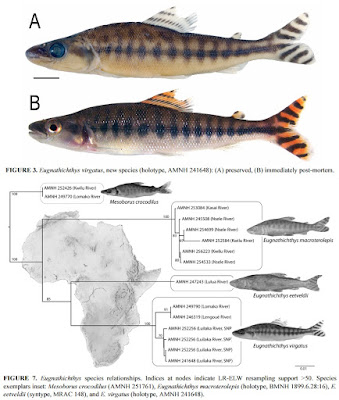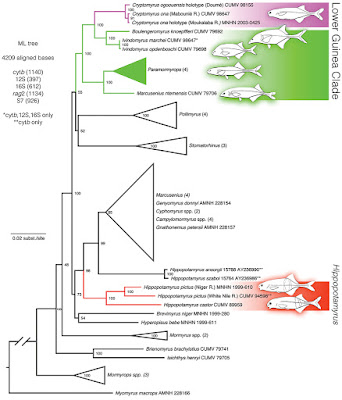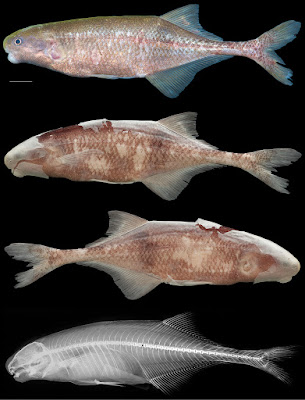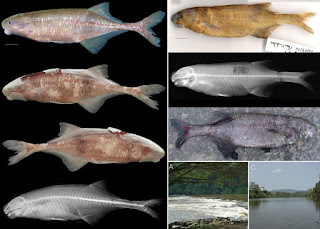[Most Recent Entries] [Calendar View]
Wednesday, February 10th, 2016
| Time | Event | ||
| 4:51a | [Entomology • 2014] Brockphasma spinifemoralis • A New Phasmid Genus and New Species of Neohiraseini (Phasmida: Necrosciinae) from Vietnam Abstract A new genus of stick insects, Brockphasma Ho gen. nov., with the type-species, Brockphasma spinifemoralis Ho, Liu, Bresseel & Constant spec. nov., is described and illustrated from Vietnam. Both sexes, the egg and the first instar nymph are described and figured. Data on the habitat and natural foodplants are provided. Brockphasma Ho gen. nov. is differentiated from other genera in Neohiraseini by spinose occiput, anterior region of mesonotum with a spinose hump and spinose anterodorsal and posterodorsal carinae of femora. A key to the genera of Neohiraseini from Vietnam is given. Key words: Neohiraseini, Vietnam, new genus, new species   Ho, George W. C., Xingyue Liu, Joachim Bresseel & Jerome Constant. 2014. Brockphasma spinifemoralis gen. et spec. nov.: A New Phasmid Genus and New Species of Neohiraseini (Phasmida: Necrosciinae) from Vietnam. Zootaxa. 3826(1):282-90. DOI: 10.11646/zootaxa.3826.1.9. researchgate.net/publication/263706626_Brockphasma_spinifemoralis_gen_et_spec_nov_A_new_phasmid_genus_and_new_sp Phát hiện chi và loài mới Bọ Que Thừa Thiên Huế | ||
| 2:22p | [Ichthyology • 2013] Eugnathichthys virgatus • A New Ectoparasitic Distichodontid of the Genus Eugnathichthys (Characiformes: Citharinoidei) from the Congo Basin of central Africa, with A Molecular Phylogeny for the Genus
Abstract A new species of ectoparasitic distichodontid, Eugnathichthys virgatus, is described from localities in the central and western Congo basin. The new species is a fin-eater even at small sizes and, in common with congeners, is capable of biting off sections of heavily ossified fin-rays of large prey species. Prior to the present study, two species were included in this distinctive distichodontid genus: the type species, Eugnathichthys eetveldii, and a second species, E. macroterolepis, both of which are widely distributed throughout much of the Congo basin. Morphologically, E. virgatus is readily distinguished from its two congeners based on a combination of meristic and morphometric attributes. The new species possesses a unique pigmentation pattern, a reduced number of pectoral-fin rays, and a markedly reduced dentition on the fifth ceratobranchial elements of the pharynx, all of which are derived features considered diagnostic for the new species. With molecular data the species is further diagnosed by four apomorphic, non-synonomous nucleotide transitions in two sampled genes (NADH dehydrogenase subunit 2 and glycosyltransferase). Phylogenetic analysis of those mtDNA and ncDNA markers supports a sister-group relationship between E. virgatus and E. eetveldii rather than with E. macroterolepis, the species with which it bears closest phenetic similarity. Keywords: Eugnathichthys virgatus, new species, ectoparasite, generic intrarelationships Stiassny, M.L.J., Denton, J.S.S. & Monsembula Iyaba, R.J.C. 2013. A New Ectoparasitic Distichodontid of the Genus Eugnathichthys (Characiformes: Citharinoidei) from the Congo Basin of central Africa, with A Molecular Phylogeny for the Genus. Zootaxa. 3693(4): 479–490. DOI: 10.11646/zootaxa.3693.4.4 | ||
| 2:55p | [Ichthyology • 2016] Cryptomyrus: A New Genus of Mormyridae (Teleostei, Osteoglossomorpha) with Two New Species from Gabon, West-Central Africa
Abstract We use mitochondrial and nuclear sequence data to show that three weakly electric mormyrid fish specimens collected at three widely separated localities in Gabon, Africa over a 13-year period represent an unrecognized lineage within the subfamily Mormyrinae and determine its phylogenetic position with respect to other taxa. We describe these three specimens as a new genus containing two new species. Cryptomyrus, new genus, is readily distinguished from all other mormyrid genera by a combination of features of squamation, morphometrics, and dental attributes. Cryptomyrus ogoouensis, new species, is differentiated from its single congener, Cryptomyrus ona, new species, by the possession of an anal-fin origin located well in advance of the dorsal fin, a narrow caudal peduncle and caudal-fin lobes nearly as long as the peduncle. In C. ona, the anal-fin origin is located only slightly in advance of the dorsal fin, the caudal peduncle is deep and the caudal-fin lobes considerably shorter than the peduncle. Continued discovery of new taxa within the “Lower Guinea Clade” of Mormyridae highlights the incompleteness of our knowledge of fish diversity in West-Central Africa. We present a revised key to the mormyrid genera of Lower Guinea. Keywords: Weakly electric fish, Mormyrinae, integrative taxonomy, phylogeny, DNA, electric organ discharge, EOD, African freshwater fishes, rarity Taxonomy Cryptomyrus gen. n. Type species: Cryptomyrus ogoouensis sp. n. Included species: Cryptomyrus ogoouensis sp. n., Cryptomyrus ona sp. n. Diagnosis: Cryptomyrus gen. n. is distinguished from all other mormyrid genera by combination of the following features. Scales large: 44 or 45 along the midlateral line, with about 42 pierced lateral line scales; mouth subinferior; broad but nonprotrusive chin swelling that does not extend beyond snout; snout expansive and rounded in lateral profile with slight inflection point visible above anterior margin of eye in lateral view; snout somewhat v-shaped in dorsal view; eye large, 19–20% HL; middle four teeth on dentary squarish, broad and spatulate, oriented nearly horizontally, central two lower teeth longest along inner edges and in contact with each other, jutting in advance of neighboring pair and forming a trowel-like shape (Fig. 6); ventral profile of head with marked concavity between gular region and chin, body depth increasing rapidly from there to pelvic-fin origin, body depth at pelvic-fin origin 21–24% SL; interorbital width 32–35% HL; dorsal-fin length 78–88% of anal-fin length; caudal-peduncle depth at end of anal fin greater than 30% of caudal-peduncle length; faint, wide and diffuse band of pigment between anterior portion of dorsal fin and anal-fin bases, darkest from midlateral region dorsally. Etymology: Gender masculine; from the Greek kryptos meaning secret or hidden referring to the rarity of these fishes in collections and the Greek myros, a kind of fish, a suffix used in the names of many other mormyrid genera. Cryptomyrus ogoouensis sp. n. Diagnosis: Cryptomyrus ogoouensis sp. n. is readily differentiated from its sole congener, C. ona sp. n., in the possession of an anal-fin origin located well in advance of the dorsal fin (first dorsal ray above anal-fin ray 7 vs. first dorsal ray above anal-fin ray 3), a narrow caudal peduncle (depth 5.1% SL vs. 6.0–6.8% SL), and lobes of caudal fin nearly as long as caudal peduncle (vs. markedly shorter). Etymology: The specific epithet is a Latinized noun in the genitive case and refers to the Ogooué River of Gabon. Distribution and ecology: Currently known only from the Ogooué River at Doumé falls. At the collection site, we recorded a water temperature of 26.7 °C, a pH of 6.89, water conductivity of 13.8 μS/cm and dissolved oxygen of 84.7%. Cryptomyrus ona sp. n. Diagnosis: Cryptomyrus ona sp. n. is readily differentiated from its sole congener, C. ogoouensis sp. n., in having an anal-fin origin located only just in advance of the dorsal fin (first dorsal ray above anal-fin ray 3 vs. first dorsal-fin ray above anal-fin ray 7), a deep caudal peduncle (6.0–6.8% SL vs. 5.1% SL), and lobes of caudal fin markedly shorter than caudal peduncle (vs. nearly as long as peduncle). Etymology: The specific epithet is a noun in apposition that honors Marc Ona Essangui, Gabonese environmental and civic activist, founder and executive director of the NGO Brainforest and recipient of the 2009 Goldman Environmental Prize, in appreciation for his efforts to protect Gabon’s equatorial forests and wetlands. Distribution and ecology: Known from the type locality in the Moukalaba River at its confluence with the Nyanga River. A second specimen referred to this species comes from the Mabounié River, a small right-bank affluent of the lower Ngounié River, below Samba Falls. Both specimens were caught by gill net at night. At the type locality we recorded water temperature of 23.6 °C, pH of 8.0, water conductivity of 116.0 μS/cm and dissolved oxygen of 4.98 mg/l. Water conductivity at the Mabounié River at time of collection of that specimen was 48 μS/cm. John P. Sullivan, Sebastien Lavoue and Carl D. Hopkins. 2016. Cryptomyrus: A New Genus of Mormyridae (Teleostei, Osteoglossomorpha) with Two New Species from Gabon, West-Central Africa. ZooKeys. 561: 117-150. DOI: 10.3897/zookeys.561.7137  Résumé Nous avons démontré avec des marqueurs mitochondriaux et nucléaires que trois spécimens de poissons mormyridés faiblement électriques, collectés à trois localités au Gabon sur une période de 13 ans, forment une lignée inconnue au sein de la sous famille des Mormyrinae dont nous avons déterminé la position phylogénétique. Nous décrivons un nouveau genre et deux nouvelles espèces pour ces trois spécimens. Cryptomyrus, nouveau genre, se distingue des autres genres de mormyridés par une combinaison de caractères de l’écaillure, morphométriques, et dentaires. Cryptomyrus ogoouensis, nouvelle espèce, se distingue de sa seule espèce congénérique par sa nageoire anale qui commence nettement en avant de sa nageoire dorsale, son pédoncule caudal gracile et les lobes de sa nageoire caudale pratiquement aussi longs que son pédoncule caudal. Chez Cryptomyrus ona, nouvelle espèce, la nageoire anale commence légèrement en avant de l’origine de la nageoire dorsale, le pédoncule caudal est large, et les lobes de la nageoire caudale sont plus courts que le pédoncule caudal. La découverte ininterrompue de nouveaux taxa dans le «clade de basse Guinée» des Mormyridae illustre notre connaissance incomplète de la diversité des poissons de l’ouest de l’Afrique centrale. Nous présentons une clé révisée des genres de Mormyridae de basse Guinée. |
| << Previous Day |
2016/02/10 [Calendar] |
Next Day >> |










